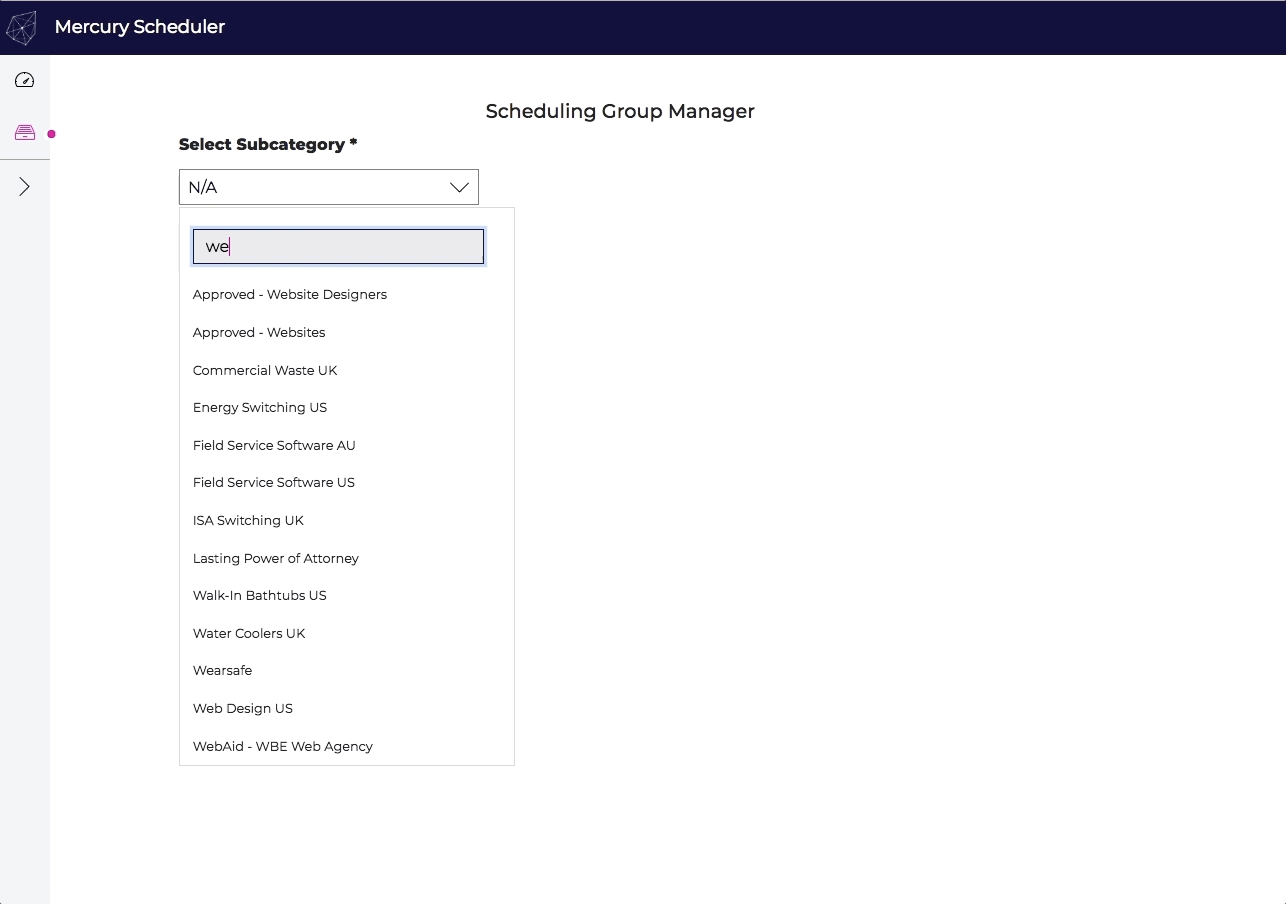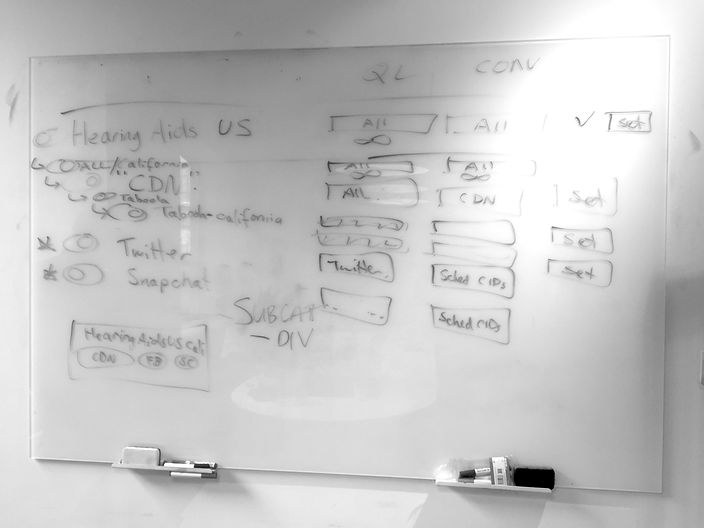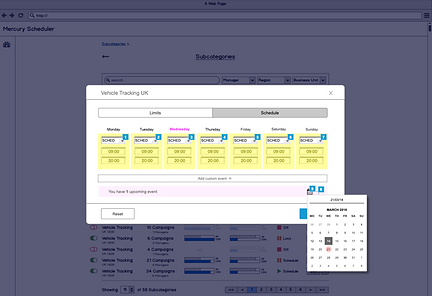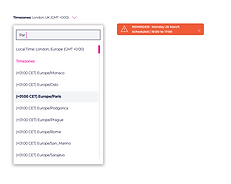Mercury Scheduler - Internal Software
MVF runs digital marketing campaigns on a wide range of channels (Twitter, Yahoo, Facebook). Campaign management has several manual stages (Sales to Ops to Marketing) and is prone to human error resulting in significant loss of GP.
As a team, we built a permanent solution (Mercury Schedular) to replicate and enhance the functionality of the google sheets. I was the lead product designer on this project working on developing key features for Releases 2- 4. The main features I worked on with the team included Compound Filtering, Timezones, Scheduling Groups and Custom Events.
On this page I will be focusing on Custom Events and Scheduling groups which I worked on for 3-6 months.
Client
Release date
Project Team
MVF
Launched in 2018
Lead designer, 4x Developers, x1 Product,
x1 Engineering Manager and x1 Business Owner

Problem and Metrics
A short term solution called Sharpe was built on Google Sheets to run these campaigns.
For Part 1 - Custom Events Marketing managers wanted the ability to customise events for days beyond the weekly schedule without altering the recurring Monday to Sunday schedule. For Part 2 - Scheduling Groups Marketing managers wanted to schedule multiple campaigns at the same time and group them in custom groups. The tool had to be responsive so the team could schedule campaigns outside of working hours if needed.
The UX Metrics I focused on included:
-
Increase the number of campaigns per person by 30% to keep up with demand for new growth to improve the efficiency of the marketing team
-
Reduce the time spent training new team members on the Sharpe sheet
-
Reduce the set up time per campaign

Image 1. Initial campaign solution built by marketing on google sheets

Image 2. New efficient and user-friendly platform
Part 1: Scheduling groups - Discovery
Scheduling groups are a customisable group of campaigns and are a key feature that would enable the business to introduce new platforms onto Mercury such as Twitter and Yahoo.
I kicked off the project with a content mapping workshop to find out from our stakeholders and users how they currently visualise and create campaign groups. By looking at their current workflow it helped the project team understand the types of campaigns the marketing users creates. This got complicated quickly as there were different ways they would create groups. For example by country, region and cities or by social media platforms in some cases. The solution would need to be designed in a way that it could work for any scenario.
Image 3. White-boarding workshop with marketing, product and developers
Information architecture and wireframes
After the workshop I moved into sketching then axure.
I created a content map with the data types to break down the information hierarchy and the way users group campaigns based on information from the workshop.
I added key actions the team would need to do such as adding, editing, deleting and renaming groups.




Image 4. Sketches exploring the aspect of creating, adding, editing, deleting and renaming groups
Visual design and user testing
After numerous meetings and discussions with the stakeholders I worked through some sketches and moved into visual design. Collaborating with the engineering team helped us understand the constraints of introducing a complex system of creating groups. I worked on several prototypes using Axure, Sketch and Invision and tested them with users through usability sessions and user interviews.
For example users were questioning how they could view the subcategories so I added a nested tree view for users to expand and view all the scheduling groups in a subcategory. A new page was added to the interface to manage the groups and users are able to create, move, rename and delete campaigns within a subcategory.




Part 2: Custom events
Marketing managers wanted the ability to customise events for days beyond the weekly schedule without altering the recurring Monday to Sunday schedule. After identifying the key tasks and interactions I started wireframing possible solutions after some quick sketching sessions.




Wireframing
I then went on to Axure to test and build the complex components. I created a prototype to test out the microcopy, interface of the application and ease of task. One of the main goals was to minimise the margin of error for the users. I used the axure designs to collaborate with dev to flesh out the interactions and UI.



Visuals and interaction design
Once the wireframes were fleshed out and edge cases answered I worked on the UI and the component interactions in details. This was done by referencing the design systems and adding new components such as calendar/list view and error messages.


Usability testing
I conducted a usability test to test the interactive elements, user flow and ease of tasks on mobile. A few usability issues were detected and then changed in the prototype. For example many users thought that the colour for the error message was for alerts. I made a few changes to the UI designs before it went to development.

Component library
For both the new features I updated the design system that I created. The design system was created to establish consistency and accelerate the design and development process for internal tools. The system was influenced by the company's brand colours and included a mix of components from basic styles, like typography, spacing, and colors to buttons and custom components & interactions.



Outcomes and Wins
As a result of the new features we scaled Mercury to be more efficient and scalable for our users. Here are some of the key results and wins.
-
Mercury training for the new team members only took half an hour, but the Sharpe training used to take 1hr 30mins.
-
The Average campaign setup time reduced from 6 minute to under 1 minute. These 2 metrics were calculated by measuring the time of task using the Spreadsheet and Mercury.
-
Costs due to errors fell from £3275/m on Sharpe to £1370/m on Mercury
